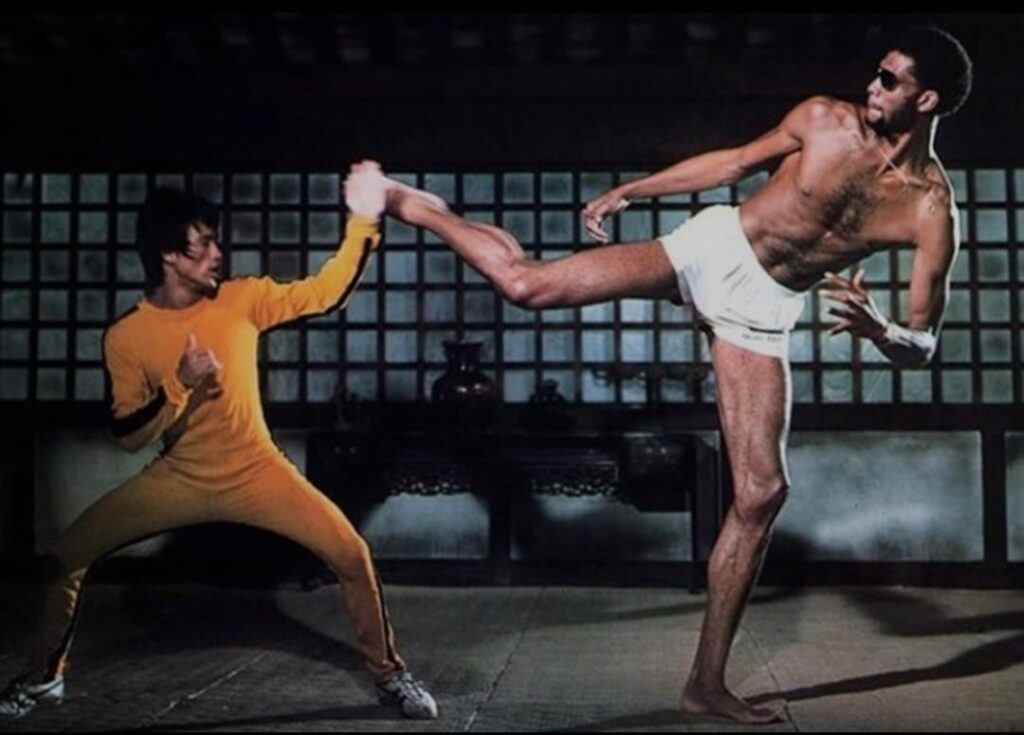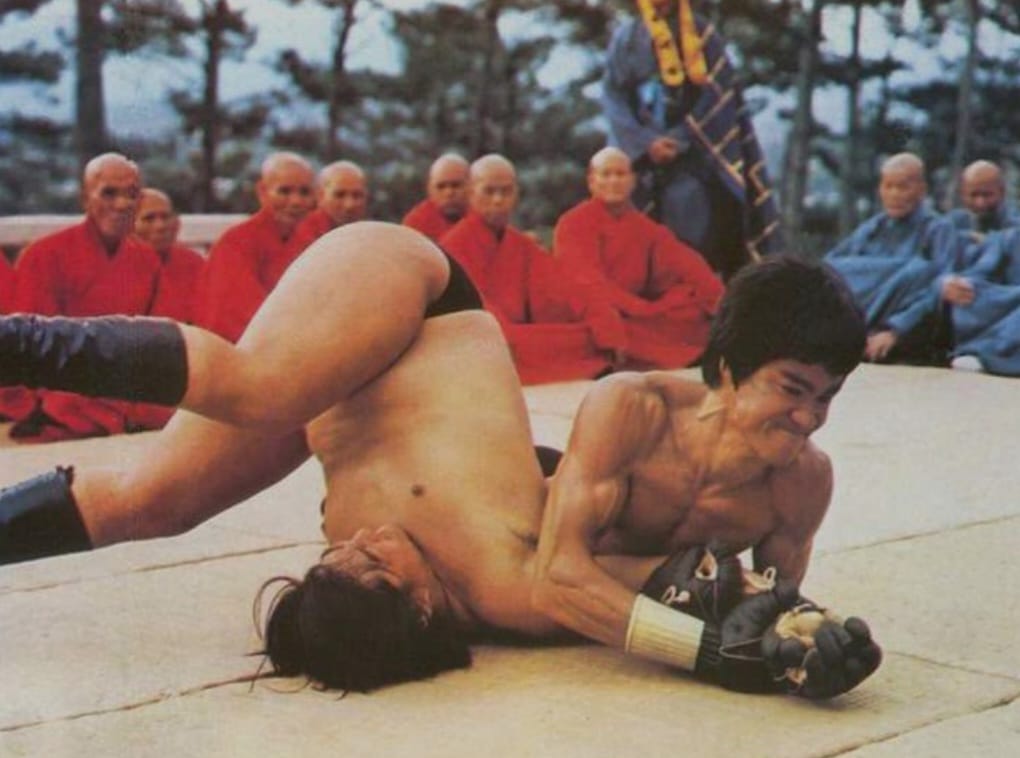
Bruce Lee transcends not just the world of martial arts but lives onward in popular culture as the point of reference for fighting arts worldwide. Time has done nothing to dull the memory of “The Dragon.” Lee, like water, has continued to flow uninterrupted while blending into the mainstream culture as seamlessly as his Jeet Kune Do. This hybrid fighting style may have just been the predecessor to the current top mixed fighting organization in the world, the UFC, or Ultimate Fighting Championship. A look at Bruce Lee through film, philosophy and as he would coin it “honest expression” his televised fights show glimpses and shades of common ground concerning the search for the ultimate in the fighting arts.
Boxing has for time eternal been seen as the final word in prizefighting but does not always translate in a street fight with no rules. Professional wrestling as an art form for fighting is great theater but pre-determined. Karate or Judo or kickboxing are effective self-defense arts. However none of these go beyond their form limits. The ability to develop a more well-rounded style allows one to be more flexible and be able to go with the flow in combat. Bruce came to understand what was or not not effective as far as fighting styles go. He ultimately found that combining aspects of the above mentioned styles made for a more complete warrior, something that the UFC was first created on, which was the desire to determine which martial art was superior and in the pursuit of this develop the ultimate fighter.
Bruce Lee was a child actor who appeared in many Hong Kong Films. He went to college in Washington state earning degree of the mind and not the fist. But by utilizing both sides of the circle he discovered quite a bit. In response to his penchant for streetlights his parents sent Bruce to train in martial arts hoping to develop discipline in their young son. He was trained by Ip Man in the art of Wing Chun which serves as the foundation of all martial arts. This in response to his penchant for getting into streetlights. It is from this that one can strike or defend. He was taught personally as Ip Man’s students refused to train with a non full-bloodied Chinese. They saw him as a foreigner since he was of mixed ancestry. This however allowed Lee to develop his art from an outsiders point of view.
By looking at Lee’s films, you will see an actor who was typecast. Once he started imprinting his honest self into his art, his personality was amplified. Bruce started experimenting with other styles, in particular boxing. As a natural lefty with excellent footwork from his years as a cha cha dancer. He believed very much that the concepts of evasion in boxing on the outside could compliment his Wing Chun concepts on the inside where his speed of hands or foot made him difficult to read. He exchanged tips concerning grappling from grappling practitioners in particular Gene LeBell, an judoka actor and stuntmen who was also a professional wrestler. LeBell added to Lee’s game catch wrestling taught to him by famous shooters Lou Thesz and Ed “Strangler” Lewis who were show wrestlers but lived in the pre-show era where a single hook move could end a match and cripple and opponent. Bruce armed now with ground attack to go along with his superior stand up style with the foundation of the inside basics of Wing Chun, he ultimately named this hybrid style Jeet Kune Do.

In the film “Enter the Dragon” in the opening fight scene he is matched with a young Shaolin student played by Sammo Hung, a partner with Jackie Chan in the Hong Kong movie scene. Lee showed several styles interchangeably first showing his boxing prowess in this scene displaying speed from a distance and with flurries of punches in close. He unleashed Judo throws and ended the match in a manner that he did not do often in the movies. He displayed a submission arm bar into a rolling pin that trapped Hung until Bruce tapped out his opponent with his own hand. This display implied a total game that was the polar opposite of the flashy kicks and punches he normally displayed in other films. He also wore gloves reminiscent of what UFC fighters use today. During filming it was rumored that he was challenged by street toughs who were used as extras on a daily basis. One would surmise that Bruce would have had to depend on a flexible style to match up that variety of opponents. The ones who point out that Lee never fought professionally outside of exhibitions miss the face that the UFC was more of a street fight than it is now and Lee fought many a street fight and came out unscathed,
The final film of his career Game of Death saw Bruce’s philosophy concerning flexibility in fighting displayed in all its glory. Lee would enter a house with several floors where on each one was a martial artist of a specific style. In the first encounter, he fights a num chucks master and uses his weapon against him to defeat him with superior speed of hand and foot. in the second duel he is matched against a Judo champion and gets flipped a few times before, once again, he adjusts and uses boxing tactics to offset the more rigid counterpart until he breaks his back on his knee. The third match was against Kareem Abdul Jabbar, a seven foot giant who played for the Los Angeles Lakers but was a Lee student. In the movie fight Jabbar height and quickness surprises Bruce until he makes an adjustment, stomping a foot, moving the geography of the fight to spots that favored him. In the end he would drive in and slug his way in until he captured Kareem in a neck lock that ended the contest. Finally at the top he fought a American tough with a cane that spouted a sharp knife out of its end and some boxing skill. He would use this to offset Lee initially but Lee countered with submission moves to get him off his feet and ultimately choke him out.
These were the building blocks that a young UFC would duplicate from their early days of single night tournament pay-per-views. This fighting series at the end of Game Death would serve as the template that UFC used where a participant would have to defeat three fighters in one night of various styles. Foe example in the first UFC Royce Gracie, the Brazilian Ji-Jitsu artist defeated a professional boxer, wrestling shoot fighter and a kick boxer to claim the honor of being the first UFC champion. As Lee studied and pursued his art he became the ultimate in martial arts fighting. He inspired a generation of movie watchers who duplicated his moves and pretended they could be him. twenty years after his death, the Octagon became the symbol of the ultimate in real fighting. Conor McGregor, a two division champion in UFC thought Lee would do well in that caged wars.
“I have no doubt he would have been world champion in MMA, no doubt” Conor explained, “He’s fluid, he’s loose, he’s fast. His movement is fluid, its efficient, it’s functional.”
Interestingly, Lee’s conditioning and his fitness obsession along with his workout sessions transcended the times. He was a student of all things that were in the realm of fighting. The lessons he passed down and mindset produced an impressive list of actors, athletes, and fighters. If you look at the more famous ones, you will notice they all aged very well even at advanced ages. Chuck Norris, Steve McQueen, Dan Inosanto, James Garner, Kareem Abdul-Jabbar, and James Coburn among many others are top examples which yells us that Bruce in his later years would have aged as slowly as his trainer Ip Man.
There are so many benefits that go beyond learning to fight in the Bruce Lee training systems. Of course, the countless men who patterned their martial arts after Bruce tells how timeless he really was. He was ahead of his time and the more you look the more new things appear. He summarized not only his fight style but a deep religious belief in how life is supported and how we should perceive it in “Enter The Dragon. The line that was immortalized was “Its like a finger pointing away to the moon,” he tells the young student, “Don’t concentrate on the finger, or you will miss all that heavenly glory.” Lee was the ultimate fighter before it was a thing and by being open to all that heaven shows, he became more than a single fantastic finger.

Luis is a twenty year veteran of the writing wars. He has served as Editor in Chief and writer of various web and print media in the Latin, Asian, and Sports genres. He has contributed as a beat writer for the WNBA New York Liberty and MLS New York Red Bulls as well as Fordham and Columbia College Football.
